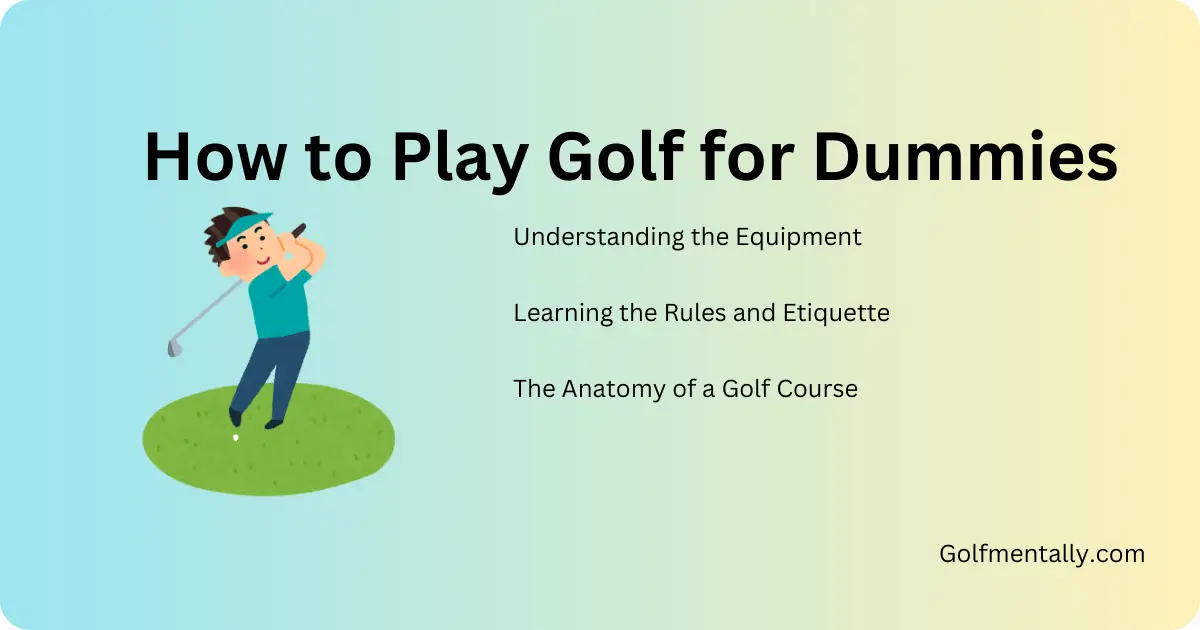Golf is often seen as a sport for the elite, but it doesn’t have to be intimidating. Whether you’re a complete novice or someone who’s always been curious about the game, this guide on how to play golf for dummies will break down everything you need to know to get started. From understanding the basics to mastering your swing, we’ll walk you through the essentials in a way that’s easy to follow and fun to learn.
Why Golf?
Golf is more than just a sport—it’s a social activity, a way to enjoy the outdoors, and a great exercise for both the body and mind. According to the National Golf Foundation, over 25 million people in the U.S. played golf in 2022, and the numbers are growing.
The beauty of golf lies in its accessibility; it’s a game you can play at any age and skill level.
The Basics: What You Need to Know
Understanding the Equipment
Before you hit the course, you’ll need the right gear. Here’s a quick rundown of the essentials:
- Clubs: A standard set includes a driver, irons, wedges, and a putter. Beginners can start with a half-set (around 7-9 clubs) to keep things simple.
- Golf Balls: Don’t splurge on expensive balls just yet. Start with durable, affordable options.
- Tees: These small pegs elevate the ball for your first shot on each hole.
- Golf Bag: To carry your clubs and accessories.
- Gloves and Shoes: Gloves improve grip, while spiked or grippy shoes provide stability during your swing.
Pro Tip: Many golf courses and driving ranges offer rental clubs, so you don’t have to invest in your own set right away.
Learning the Rules and Etiquette
Golf has a reputation for being a gentleman’s (or gentlewoman’s) game, and that’s largely due to its emphasis on etiquette. Here are some key rules to keep in mind:
- Respect the Course: Repair divots (chunks of grass you displace) and ball marks on the green.
- Stay Quiet: Avoid making noise while others are taking their shots.
- Pace of Play: Keep up with the group in front of you to avoid slowing down the game.
- Safety: Always check your surroundings before swinging to ensure no one is in harm’s way.
The Anatomy of a Golf Course
A standard golf course has 18 holes, each with a tee box, fairway, rough, hazards (like sand bunkers and water), and a green with a flagstick and hole. The goal is to get the ball from the tee box into the hole in as few strokes as possible.
How to Play Golf for Dummies: Step-by-Step
Let’s dive into, how to play golf for dummies in details.
Step 1: The Grip
Your grip is the foundation of your swing. Hold the club with your lead hand (left hand for right-handed players) and place your trailing hand below it. The “V” shapes formed by your thumbs and index fingers should point toward your trailing shoulder.
Step 2: The Stance
Stand with your feet shoulder-width apart, knees slightly bent, and weight evenly distributed. Position the ball closer to your lead foot for longer shots and centered for shorter ones.
Step 3: The Swing
The golf swing can be broken down into four parts:
- Backswing: Rotate your shoulders and hips to bring the club back.
- Downswing: Shift your weight to your lead foot as you swing the club downward.
- Impact: Strike the ball with a square clubface.
- Follow-Through: Continue the motion, finishing with your chest facing the target.
Pro Tip: Start with slow, controlled swings to build muscle memory. Speed and power will come later.
Step 4: Putting
Putting is all about precision. Use a light grip and focus on a smooth, pendulum-like motion. Keep your head still and eyes on the ball.
Common Mistakes Beginners Make
- Over-swinging: Trying to hit the ball too hard often leads to poor contact and loss of control.
- Poor Alignment: Make sure your body and clubface are aligned with your target.
- Ignoring the Short Game: Many beginners focus solely on driving, but putting and chipping are just as important.
Practice Makes Perfect
The best way to improve is to practice regularly. Start at a driving range to work on your swing, then move to a par-3 or executive course to get a feel for playing on an actual course.
Conclusion: How to Play Golf for Dummies
Learning how to play golf for dummies doesn’t have to be overwhelming. With the right mind-set, equipment, and practice, you’ll soon find yourself enjoying the game and improving with every round. Remember, even the pros started as beginners, so be patient with yourself and have fun. Golf is a journey, and every swing brings you one step closer to mastering it.
FAQs
What is the easiest way to learn golf for beginners?
Start with the basics: learn proper grip, stance, and swing mechanics. Practice at a driving range and take lessons from a professional to build confidence.
How do I choose the right golf clubs as a beginner?
Opt for a beginner-friendly set with a driver, a few irons, a wedge, and a putter. Many brands offer affordable starter sets designed for new players.
What should I wear to play golf?
Wear comfortable, collared shirts, golf shorts or pants, and spiked or grippy golf shoes. Avoid denim and t-shirts unless the course allows it.
How long does it take to learn golf?
It varies, but with consistent practice, beginners can start enjoying the game within a few months. Mastering golf, however, can take years of dedication.
What is the most important skill in golf?
The short game (putting and chipping) is crucial. It accounts for over 50% of your strokes, so practice it regularly to lower your score.
How do I avoid common beginner mistakes in golf?
Focus on proper grip, alignment, and tempo. Avoid over-swinging, and don’t neglect practicing your short game.

James Smith is the author of a website called Golf Mentally. He believes that golf is as much about thinking as it is about swinging the club.
Golf Mentally helps golfers of all levels. It teaches new golfers the basics, like how to hold the club and hit the ball. It also helps more experienced golfers learn new things and improve their game.
James wants to help golfers think smart on the course, not just hit the ball hard. He believes that by thinking about your shots and staying positive, you can play much better golf.

